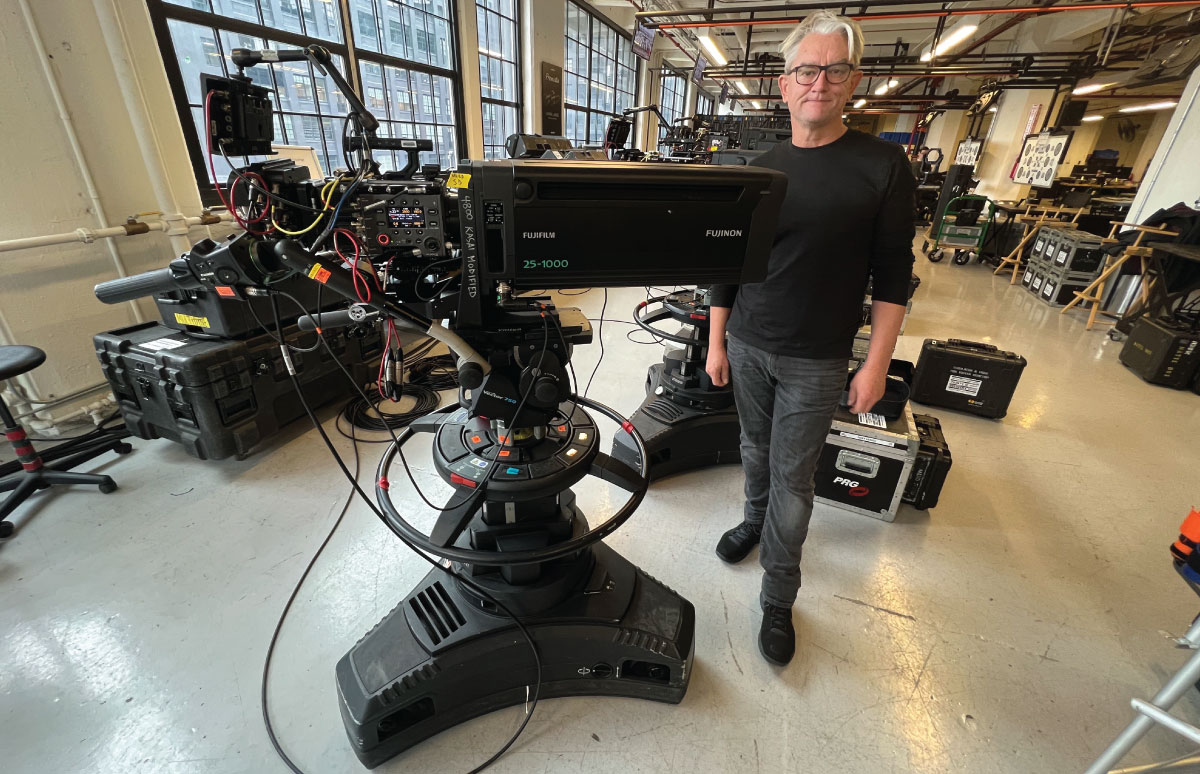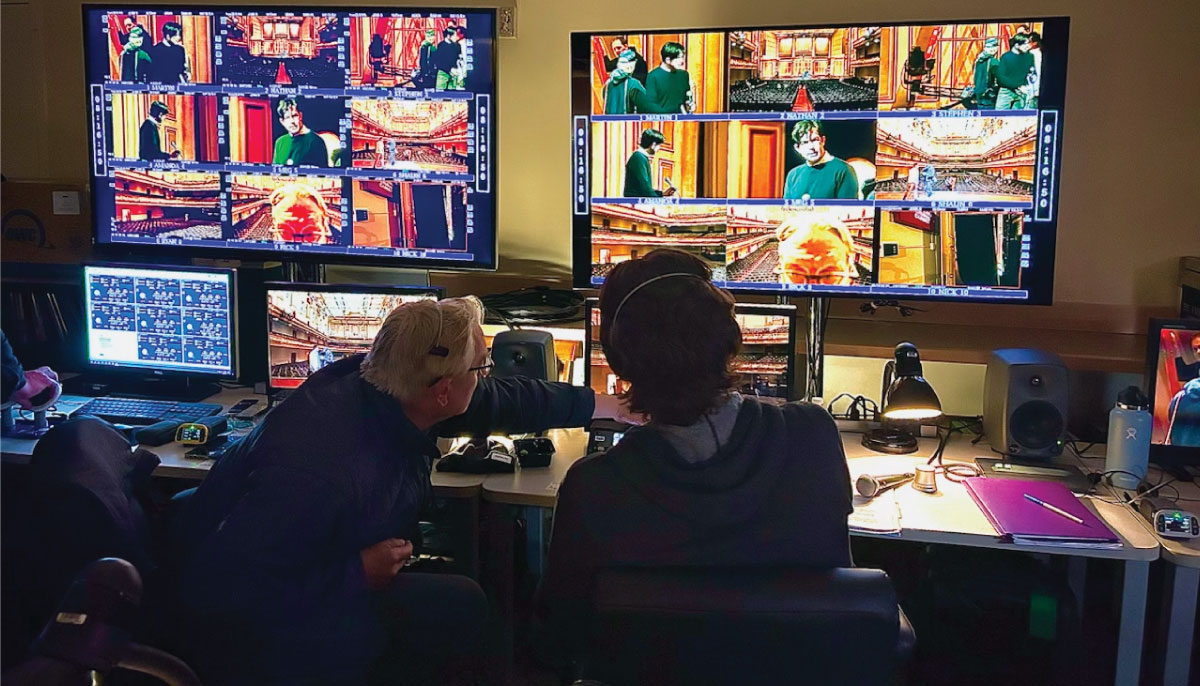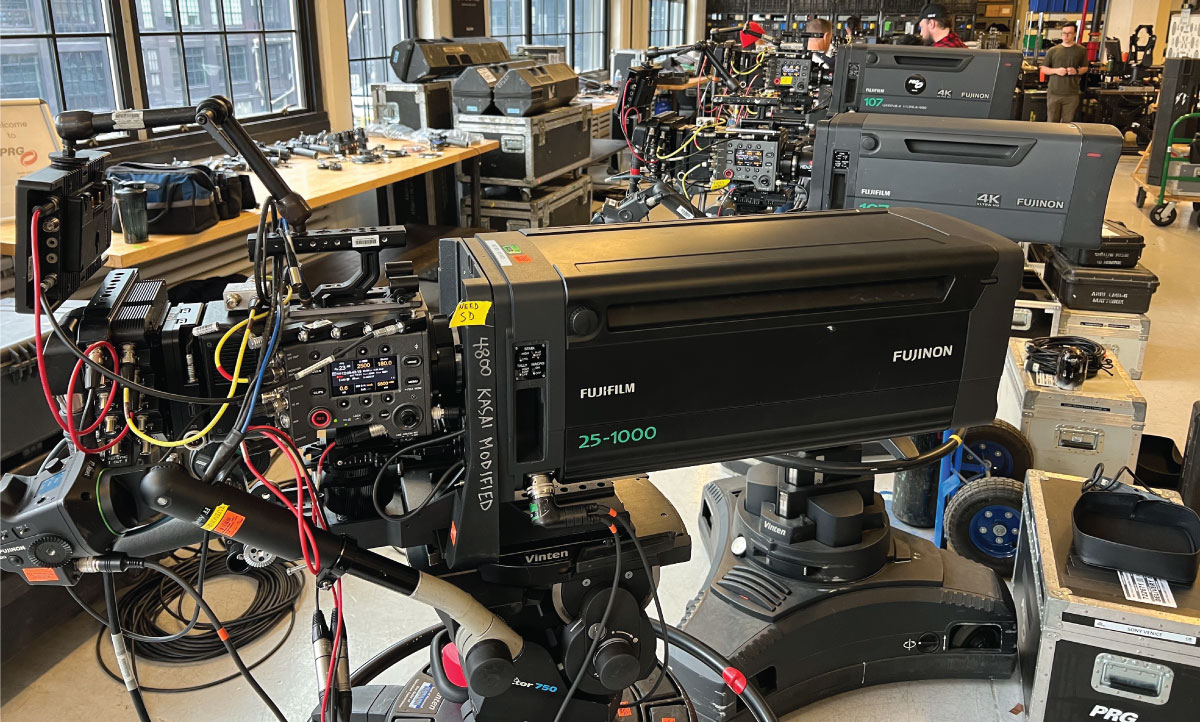Interview with DP Cameron Barnett, ASC
John Mulaney: Baby J and the new Fujinon Duvo Lens.

Director of Photography Cameron Barnett is a pioneer in cinematic multi-camera shooting. Using the some of the first ever ARRI Alexas, he helped capture one of the first Super 35 sensor live broadcasts on the 2010 Victoria Secret Fashion Show. He then continued to strive for all Super 35mm capture and was successful in recording Kevin Hart’s 2015 performance at the Lincoln Field in Philadelphia in front of an audience of 55,000 people. It’s only been 8 years since then, but things have come a long way. John Mulaney’s Baby J comedy special debuted this week on Netflix, for which Cameron got his hands on one of only 5 of the game changing Fujinon Duvo 25-1000 PL box lenses.
Driven by the increasing presence of Super 35 and larger sensors at sporting events and concerts, paired with the drive to create more cinematic imagery in broadcast, the HZK 25-1,000 mm is a new kind of box lens. It features an astounding 40x zoom range, all the way from 25mm at its widest to 1000mm at its longest. This lens was perfect for the comedy special, shot live at Boston's Symphony Hall. Cameron and his crew were able to capture intimate, prime lens quality close ups of Mulaney while inconspicuously tucked 100 feet away.
PRG: Let’s start from the beginning: how did you get your first job in the industry?
Cameron Barnett: I was a film student in Australia, and I did a degree in media studies that had a film-production component. I was less interested in the academic, and far more interested in getting out there and using the cameras. My whole background is single-camera film, and I started working on films as an assistant. I then had the opportunity to work on a television series filming in Hong Kong. So, I went and stayed there for six months.
A lot of the crew was British and convinced me that I’d find work if I went back with them to London. And so, I thought, why not go for it? I went to London and stayed. One of the first jobs I got was working was on The Russia House, which is a 1990 American spy film directed by Australian director, Fred Schepisi starring Sean Connery and Michelle Pfeiffer. From that moment my career never stopped evolving in different ways. I didn’t just stay in the feature or narrative industry, I went off into documentaries and music videos, and continued working on film and single camera.
PRG: Tell me about some of the work that came next.
CB: With the BBC in London, I shot documentaries all over the UK: in Scotland, Wales, Ireland. It's a great industry in Britain. I really cut my teeth there and am thankful for the timing of being there and the opportunities that arose.
The BBC was where I also had experience shooting in war zones… all by myself. That's when I started to move over a little bit into a single camera, on tape, since you can't really have film in that situation. I went to Somalia, Iraq and Algeria. The thing about it was thinking on your feet and being able to do things very, very quickly. Get what you need and get out of there before a bomb explodes.
Then I began shooting music videos in the United States and I was traveling backwards and forwards to New York from London, also Los Angeles and sometimes the Midwest. We did a few documentaries including one about the Russian mafia in New York.
After all that, I began to focus on work with companies like Done+Dusted. I began working with Director Hamish Hamilton, who was supportive of new technological advances and ideas, especially with cameras and lenses.
PRG: We haven’t even touched on your more recent work yet, but that is an inspiring journey for aspiring Directors and DPs. I see the common thread here being what you call the single camera approach. I think the cinematic quality of your work is what makes it stand out, whether it’s a film, documentary, music video, a concert or a comedy special.
CB: The single-camera approach really is the crux of it for me. For multi-camera work, I treat each camera like it is being shot in a narrative style. It sounds like a paradox until you watch a performer move around a stage and then develop a plan to move the camera with them and be there to capture all the nuance and expression. In the broadcast space, you understandably throw a lot of cameras at a project to make sure you have enough coverage and angles, but it's a bit of a blanket approach.
In recorded live, I treat every single camera as a standalone angle to get the absolute best out of it. Even though there is an audience, we have more flexibility to interrupt the normal show. In the case of Baby J, John Mulaney’s new show, Alex Timbers the Director and I did things like putting a rail cam in the middle of the stage for an entire show. We also started the show with a Steadicam standing in the middle of stage, with his back to the audience revolving around to reveal that the audience was already in place. You really must be able to collaborate with great directors and artists like Alex Timbers and John Mulaney to make moments like this come to life. This is when trust becomes the most important thing.
This also means putting a different lens on each camera, sometimes a prime which can drive tech managers crazy due to the compromise in control on the lens. Brett Dicus, who was tech manager for Baby J, was very supportive in making sure we had cameras in perfect positions. The big change is in color rendition. You will see this clearly on the Baby J special.
Up until now, in the broadcast space, there has been a smaller sensor of capture, 2/3’’ and a lower data acquisition (usually 10-bit recording), which has been fine for most news, sports and live TV. Whereas with Super 35mm and large-sensor capture, it allows for much greater depth in data and color tonal variations (acquisition up to 16-bit recording in trillions of colors).
For me, the other priority is to do as much as you can in the camera, rather than wait for post-production. For me, it's trying to capture as much production value in the camera, through the lens. And then you can build on that in post, if you know the creative team. Whether it's a colorist, editor or director, they've got a lot of opportunity to do whatever they want to enhance a shot in post. I like to be able to bring the footage to them and say, “this is the highest quality footage I can bring you and this is my interpretation of what we're doing.”
PRG: As you know, we’re also evangelists for the cinematic multi-cam approach at PRG. I understand that you were able to rent one of our new Fujinon Duvo lenses on John Mulaney’s Baby J comedy special that just debuted on Netflix. Can you tell me why this lens is a game changer for cinematic multi-cam work?
CB: The problem has been that you cannot use spherical or anamorphic lenses if you're 100 feet from the artist and you need a close-up. Up until now, there have been two choices: a spherical PL lens with one or two doublers, or a TV box lens used for 2/3” broadcast and an expanding 35 adaptor to cover the Super 35 sensor.
What we've been able to do up until now, with solutions like the 35LIVE! system, is work around the image expansion issue through an adaptor to expand the image. Now with this new lens, there's no adaptor. The Duvo, which is a PL mount lens, removes the adaptor issue as well as the degradation in image quality that occurs any time you place a layer between the lens and the sensor.
PRG: How was your experience working with the lens?
CB: It was amazing. Like night and day. it's like shooting on a single prime lens from 100 feet. It's an extraordinary piece of glass made for long distances. I was so far away, but it really looks like I was very close to John and shooting him on a prime lens.
PRG: Can you describe your camera setup for Baby J?
CB: The Boston Symphony Hall where we shot this special is very long, so immediately that produced some unusual challenges. There is a need for 360 degrees and cameras in full rotation to capture every movement of the artist and where they gesture. So, in this space we had to break the capture up into separate shows. Otherwise, the cameras and moving elements would have been seen in the shots.
So then we had to decide if there was a Steadicam. Does it move? Do we shoot it all in one show and then take it out for the second show?
There is a lot of time and energy spent on the scout, but also going and sitting in the room for a show. You try and get a sense of the energy of the room and how an audience is going to respond and how they're going to move. They moved a lot causing our cameras to bounce on what was a sprung floor for dancing, and not an ideal situation for a close up from 100 feet.
You look at the artist’s previous shows that have been taped from front of house and watch the way they move. John Mulaney, who's doing a show about rehab, talks about the fact that he used to dart around quickly when he was on drugs, but now he moves really slowly and intentionally, which is great for his health and great for the crew shooting his special.
To sum it up: we had three cameras across the front, a full length, a cowboy shot, a mid-shot and a close-up. We also have those cameras there in multiples because if one camera stops working, there’s no time to fix it and the other camera can change assignment to cover.
We shot three shows, one the first night and two the second night. And on the first night, Alex and I decided to just blow it! Let's just forget hiding cameras for the first show. The room won’t allow us to hide anything. There are no wings. The audience, they're here to see a guy who's talking about rehab. They're up for it, right?
So, for that whole first show the rail cam just went backwards and forwards on stage. We also had also a 35-foot tower cam just off stage, going to full height and coming back down on specific moments of the show. We also had a Steadicam on stage.
The second night, we flipped the rail cam and put it down at the front stage on the front edge. And we took the tower cam and we put it all the way to the back behind those 3 front cameras where it just went up and down to a full height of 35 feet.
For multi-cam, I always try and get as many of one style of glass as I possibly can so that the color bias is seamless, which makes the graders job easier in balancing, I don't want the viewer to see the difference in lenses unless it’s called for by the creative. At one moment in the show, the Steadicam moves on stage and uses a wide lens to enhance a section where John talks about an experience before his rehab. The wide lens changes the longer lens style we are accustomed to and is immediately jarring, intentionally.
PRG: You’ve worked with the 35LIVE! system for a long time now. Tell me about the experience with PRG.
CB: We prepped for this special at PRG Brooklyn and it was amazing. We got there, and everything was already set up, so by the time the ACs walked in it was kind of done. It was so smooth and it was fantastic to see the Fujinon 25-1000 lens on the on the camera.
Over the years, I have always been happy to work with PRG. I’ve worked with Vivian Umpierrez very closely on a handful of shows, including the Jonas Brothers Happiness Continues concert film and on Kevin Hart's Irresponsible in London at the o2 arena. On that show, we shipped 24 cameras to the UK. Because I had such a weird shopping list for the Jonas Brothers, it became clear how dedicated she was to me as a client. She tracked down every unusual anamorphic lens in existence. Vivian was on the phone with reps in different countries finding us the gear we needed because we shot in Vancouver and Mexico. She always takes my call and she never says no. I can’t ask for more than that.
Learn more about Cameron's work and reach out to him directly via his website— www.cameronbarnett.com

